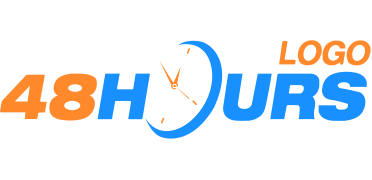 Every industry has it’s own language, and graphic design is no different. At 48hourslogo.com we believe stronger communication will lead to better results in logo design. In order to help strengthen the conversation between clients and designers, we’ve brought together a list of common terms used by graphic designers. Next time you’re loving a design but “something” is missing that you can’t put your finger on, one of these terms may be key in fixing it.
Every industry has it’s own language, and graphic design is no different. At 48hourslogo.com we believe stronger communication will lead to better results in logo design. In order to help strengthen the conversation between clients and designers, we’ve brought together a list of common terms used by graphic designers. Next time you’re loving a design but “something” is missing that you can’t put your finger on, one of these terms may be key in fixing it.
Techincal Terms
 Vector Graphics : a computer image that is stored in memory as lines rather than dots, allowing it to be rotated or proportionally scaled.
Vector Graphics : a computer image that is stored in memory as lines rather than dots, allowing it to be rotated or proportionally scaled.
All logo designs submitted on 48hourslogo.com are vector graphics. Two vector files are included in all our Logo Packages, an EPS and PDF. This ensures that you have files you can scale to any size you will ever need, whether you’re placing a logo on pens or billboards.
 Raster Graphics : also known as “bit-mapped”, a computer image that is held in memory as a series of colored dots in a grid, each dot represented by one or more bits.
Raster Graphics : also known as “bit-mapped”, a computer image that is held in memory as a series of colored dots in a grid, each dot represented by one or more bits.
These types of graphics are what is being used when you see an image get blurry or pixelated. They’re created at a fixed size, so enlarging it will cause it to decrease in quality. Two raster files are included in all our Logo Packages, a high resolution JPG and a PNG with a transparent background.
Negative Space : defined as empty space around an object or form, also called “white space.”
Negative Space is used to create illusions or shapes in logo design, most often in a black and white setting. The examples below (needdentures.com by peacock and The Iron Report by Jaize) use the empty white space to create the image of a tooth and muscle man respectively.
 Color Terms
Color Terms
This color model is used for the web. These primary colors, exchanging yellow for green, are additive and are used to brighten monitors as light. This RGB Color Wheel shows Primary, Secondary, and Tertiary colors.
CMYK : Cyan, Magenta, Yellow, and Key (Black, not to be confused with B in RGB).
This color model is used for printing. Secondary colors are better used for mixing pigments since they mix subtractively instead of additively. They are subtractive in that they subtract brightness from white. Between the Cyan, Magenta, and Yellow, there are one million color variations you can achieve.
PPI : Pixels Per Inch
A measure of the resolution, in pixels, of an image within a specified space, typically digital displays or image scanners. A pixel is simply the smallest colored dot that lights up an image. For use on the web, images are typically 72PPI so they will load quickly.
DPI : Dots Per Inch
A measure of resolution used for printed text or images, more dots per inch means a higher resolution. 300DPI is the standard for a high resolution image.
Typographic Terms
 Kerning : The setting of two letters closer together by removing space between them.
Kerning : The setting of two letters closer together by removing space between them.
This will help clean up the setting of letters in your logo when there’s something a little off about it. Our eyes notice when there’s too much or not enough space, making it subconsciously distracting. Some fonts inadvertently leave too much space because of how the letters are shaped, and can be brought together through kerning.
Alignment : Refers to arrangement in a straight line.
There are three primary types of alignment in design; left, right, and centered. Most logos that are an icon and text are left alighted, with the icon on the left and the text next to it with some buffer room. Logos consisting of just a symbol or just text are centered. Right alignments are trendy or serve a purpose with another design element the logo is used with.
 Serif : A small line used to finish off a main stroke of a letter.
Serif : A small line used to finish off a main stroke of a letter.
Serif’s are decorative and used in font’s like Times New Roman and Trajan Pro. They give a look of antiquity, professionalism, and history to design.
 Sans Serif : sans is Latin for “without”, so literally “without serifs”.
Sans Serif : sans is Latin for “without”, so literally “without serifs”.
Fonts like Helvetica, Arial, or Century Gothic are all sans serif. They are used in modern logos for a look of simplicity and cleanliness.
Having these terms in your verbal arsenal should help create smoother conversations with the design community. You can start a new contest with them today by clicking here.
Let me know in the comments if this has helped or if you have any terms you’ve learned over the years that you think would help others out!
Don’t miss our latest Featured Designer interview with aRBy! For more helpful tips check out our Expert Recommendations for Your New Logo!

